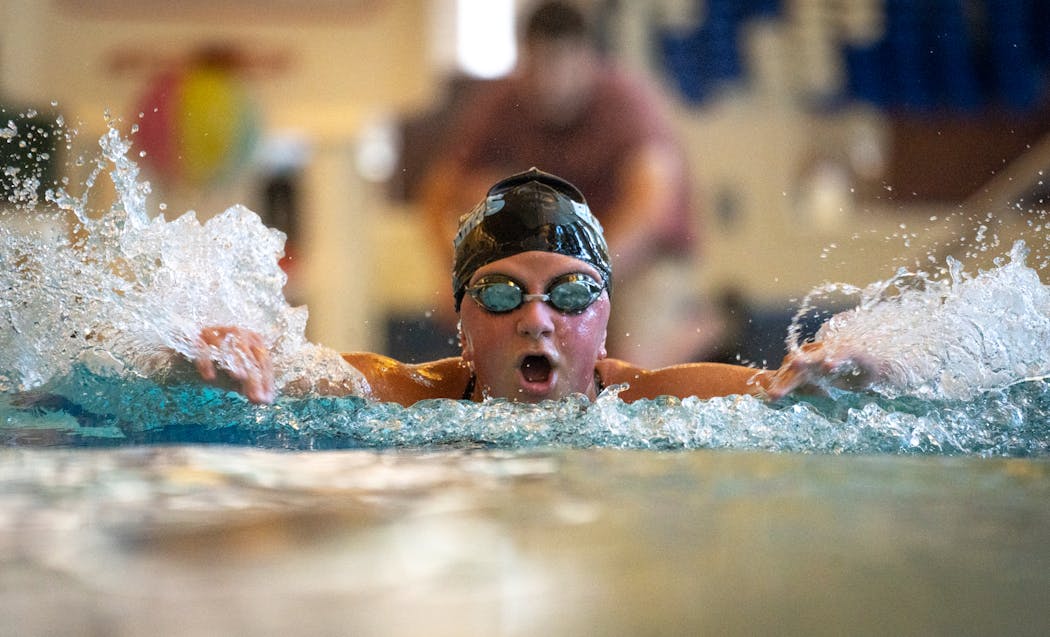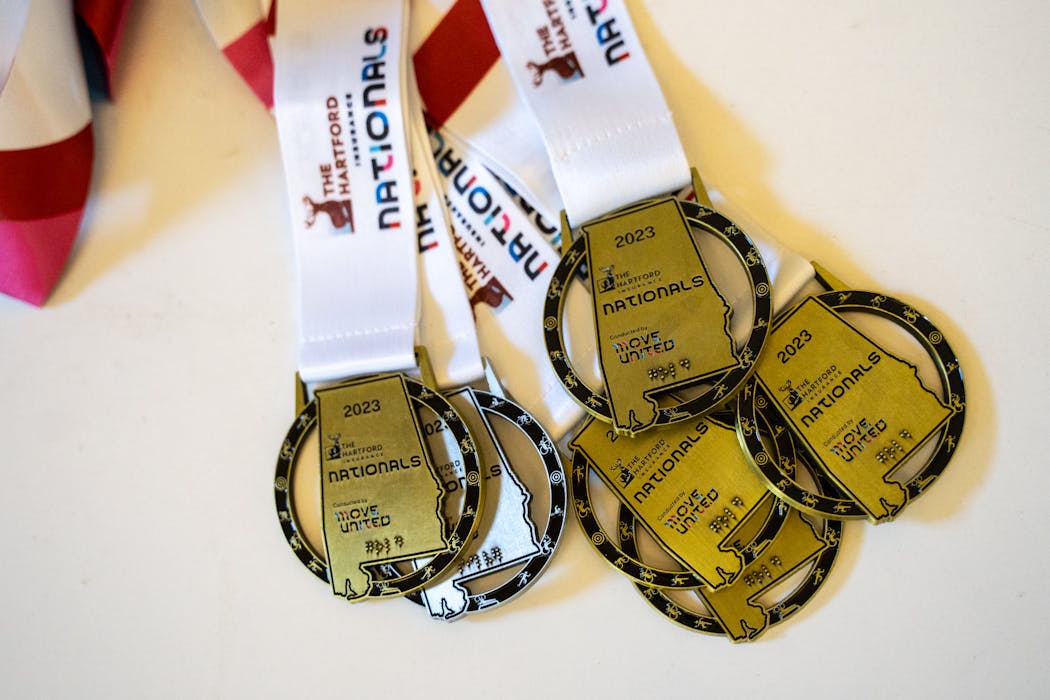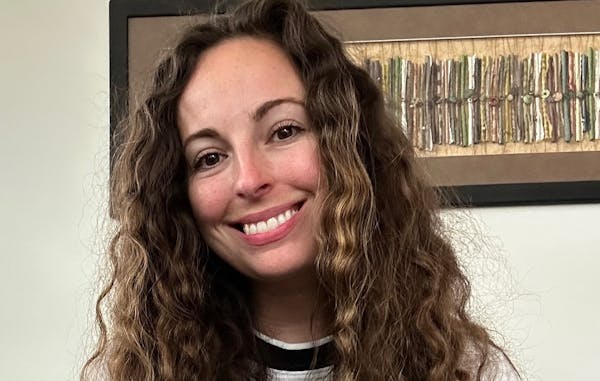At 14 years old, Sophia Nohre has broken more than 100 bones. She once broke a bone giving someone a high-five. When she was little, her mother picked her up and felt her daughter's rib break under her fingers. She started walking when she was 2, the next day jumped with excitement, came down, broke a bone in her foot, and stopped walking for a long time after that.
Sophia, who lives in Alexandria, Minn., was born with a genetic condition called osteogenesis imperfecta, or brittle bone disease. She has undergone almost 20 surgeries on just her femurs alone. Femurs are thigh bones, the strongest bones in the body, stronger than steel or concrete in most people.
She can walk on her own but uses a wheelchair, walker or crutches in environments that might be jarring. She can break a bone by falling a short distance or even twisting the wrong way.
"She has to be very careful," said her mother, Christie Nohre. "There are lots of sports she can't do."
But Sophia can swim. Man, can she swim.
She slices through water with no visible impediment. Butterfly, backstroke, breaststroke, freestyle — sometimes all together in 50-meter legs of one big race, the 200-meter individual medley.
"She's hitting times that would be impressive on a traditional [nondisabled] high school swim team," said her coach, Adam Warden.
Aside from slight adjustments in how she kicks or launches off a pool wall, her form doesn't look much different from that of other swimmers, Warden said.
"In the water, she's as normal as could be ... her body feels good," Christie Nohre said.
Sophia has been swimming competitively since she was 7. In July, she competed in the Harford Nationals, a long-running adaptive sports tournament held by Move United, a national organization affiliated with the U.S. Olympic & Paralympic Committee. She went to Birmingham, Ala., where she was up against top athletes with disabilities from all over the country.
She came home with five gold medals and a silver.
"That's phenomenal — that's huge," Warden said. "Those athletes are competing at the absolute pinnacle of performance."
But perhaps Sophia's most impressive feat is her unflagging drive. The petite athlete — she's 4 feet 8 inches tall — is matter-of-fact about her condition, undaunted by its challenges and determined to push herself beyond other people's expectations.
"Yeah, I try everything, except for heights — I have a fear of slides," Sophia said cheerfully after emerging from the water at a recent practice in the pool at the Courage Kenny Rehabilitation Institute in Golden Valley. For the most part, though, she doesn't let her disability get her down.
"It's like, sure, you have broken bones and things like that," she said. But "if I'm not happy, that makes it worse."
'Doesn't give up'
Things Sophia has done and enjoyed: batting and pitching in softball, swimming for two miles in open water alongside her family's boat, playing Crutchie in the musical "Newsies" at the Andria Theater in Alexandria earlier this summer, archery.
Things Sophia has not done but wants to: playing catcher in softball, doing a four-mile swim from Bayfield, Wis., to Madeline Island in Lake Superior and back, skateboarding with the help of a walker, competing in the 2028 Paralympics in Los Angeles.
"She's pretty tough," her mother said, but added, "She has to be very careful — there are a lot of sports she can't do."
But Sophia likes to push against perceived limitations.
"Sometimes my mom is like, 'Don't let her do that' — sometimes she says it too late," she said, grinning, with a glance at her mother, standing out of earshot in the Courage Kenny pool room. "I definitely know me better than anyone else, so if I know I can do something I will argue my ability to do it."
Some of her goals are ambitious for any 14-year-old, let alone a girl who uses a wheelchair in crowded places because brushing against other people could cause fractures. But her coach has confidence in her, including her shot at the Paralympic Games, held every four years after the Olympics.
"I absolutely think that's a realistic goal for Sophia," said Warden, 42. He himself is a multi-talented athlete who estimates he has done more than 150 triathlons since high school, despite the lingering effects of breaking his back while stationed in Iraq and having lost part of his left leg after being pinned under a tree in 2014.
In Alexandria, Sophia belongs to a swim club with kids who don't have disabilities. "They're like family," she said. But she also likes being in settings, like Courage Kenny's adaptive swim program, where she can be among athletes with disabilities and watch them confront their own challenges: a kid missing half an arm riding a skateboard, a guy with no arms gripping a towel in his teeth to pull himself from the pool.
Injuries have forced Sophia to miss a lot of school and practices over the years. In 2022, she was out for surgery on a broken femur, recovered, then tripped over the family dog and fell, breaking the same leg in a different place.
"It always surprises me that she doesn't give up," her mom said. "After it's happened so many times, I don't know many people who wouldn't give up."
Instead, when Sophia healed enough to return to practice, she worked extra hard to catch up.
"The second she's able to get back out there, she's back out and pushing herself hard to get going," Warden said. He designs workouts for the swimmers he coaches, focusing on endurance, speed or form. He does his best to challenge Sophia. Recently, he wrote an especially "brutal" one.
"I thought, all right, this one is going to wear Sophia out," he said. When she got out of the water, he asked her what she thought. "Eh," she told him, "it was fine."
She also keeps up in school despite her absences, either doing homework while she's out or staying after school when she gets back, getting mostly A's.
"I signed up for an honors science course, and everyone's like, 'Why would you do that?'" she said with a shrug. "I like science."
She would like someday to work in forensic science. Meanwhile, she enjoys painting with acrylics on canvas — mainly landscapes, though she's working on faces. In addition to the "Newsies" role, she has acted in school plays and would like to do more theater.
"If I could say something — and this is mainly directed to the kids in my school that I know are doing nothing right now," she said. "Get out of bed and do something."
Singing, ceremonies and straw hats: Olympics opening ceremony in Tahiti centers Polynesian culture

Three 101-year-old friends recall fond memories in 1940s Alexandria
Celine Dion makes musical comeback at Paris Olympics with Eiffel Tower serenade






